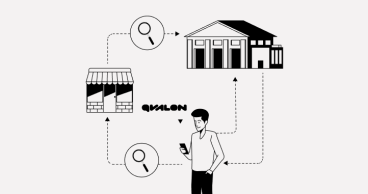Qvalon Blog article content
Any innovation or technology should fulfill the very need that led to its origin and bring real-life benefits to people. The same stands true for any type of progress in the business world.

Any positive impact directly or indirectly translates to improved financial performance. For example, CSR activities lead to higher employee motivation, better brand image, and stronger customer relationships. In the long run, these benefits lead to increased profits. In comparison, the advantages of innovative technology can be noticed quickly and are more significant than the rest.
The same is true for QVALON. Quick improvement in financial performance is observed in businesses that integrated their operational activities with QVALON. For instance, Burger King fast-food restaurants reduced their cleaning costs by 9%. Through insights, they were also able to include specific clauses in cleaning contracts that interlinked payouts with performances. This allowed for optimum use of investments made in cleaning and hygiene with the best possible results.
Your business stands to achieve similar or better results through systematic and structural integration of QVALON.
Direct and indirect impact
As explained above, the positive impact can be direct or indirect, depending upon the approach and the change. To understand better, let us take the example of a fashion store, whose KPI’s can be influenced by business processes such as,
|
Business processes and standards |
Influence |
|---|---|
|
Customer service standards |
Increase in sales conversion from store visits. Increase in customer loyalty. |
|
Merchandising standards |
Better quality control within lesser time. UPT increase (units per transaction) |
|
Marketing activities standards:
|
Increase in footfall (store visits by customers). Increase in the number of units sold. |
How to verify the results of using QVALON
To measure QVALON’s impact on financial performance, the following approach is recommended.
Step 1
Identify the key KPI (or set of KPIs) and metrics that you want to track over a specific period. Set benchmarks before starting with QVALON, against which future performances will be measured or compared. It is suggested to start with one or two KPIs and then to expand it to cover all facets of the business.
Step 2
Create a checklist to control the operating processes that directly affect the KPI(s) and metrics selected in the previous step. For example, if you want to estimate units per transaction, then you can include the following questions in the checklist:
-
The entire approved range of bags is displayed in the store;
-
The entire approved range of stoles is displayed in the store;
-
Display look is formed by the merchandising requirements;
-
There is an approved assortment for cross-merchandising in the billing area;
-
The cashier offers additional goods based on the final billed amount.
Step 3
Choose multiple stores with approximately identical scores according to certain criteria:
-
Location (city, region);
-
Store visits;
-
Monthly maintenance;
-
Number of personnel;
-
Sales volume and so on.
It is suggested to choose an even number of stores from different commodity turnover clusters.
Step 4
The selected stores are to be divided into two groups:
-
Pilot (with seasonal/regular audits);
-
Comparative (which will not be audited).
The results of the stores in the second group will be required for analysis against the results of the first group.
Set a task for regional store managers of the pilot group to monitor the UPT for a specific period (at least one month). Plan an audit schedule, which will be conducted on a thematic checklist (formulated in Step2).
The participating auditors should not only perform audits but also monitor the elimination of the identified violations, along with the dynamics of tasks execution within the checklist.
Step 5
After the set period, compare the results of the selected KPI in both groups before and after using QVALON. The difference in indicators is the result of QVALON’s performance. To maintain the authenticity of the test period, it is recommended to not inform store managers about their involvement in the trial.
If you are looking for the guarantees
Businesses are curious to know what kind of guarantees a technological innovation Like QVALON can provide. This curiosity can be answered with an example. The manufacturer of a hammer cannot guarantee that you will make more money with it. It is up to you to learn how to nail quickly and accurately, and you can do your job quicker, and therefore earn more money. So QVALON can reflect a business’s shortcomings, and even recommend possible solutions but to not implement them or not promptly is entirely the business’s prerogative.
As a technological tool, QVALON is convenient, efficient, and multi-functional. But it is still a tool that is managed by people, so financial results will depend on how effectively it is used by the workforce. On QVALON’s part, there is consistency in the execution of operational standards across the entire organizational network. It maximizes business efficiency, resource utilization, and compliance requirements to increase profitability. It also provides leadership with analytics-based intelligence and workforce development tools that drive results. At QVALON, our team delivers a personalized, simple, and cost-effective approach to growing your business.


